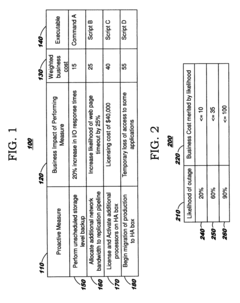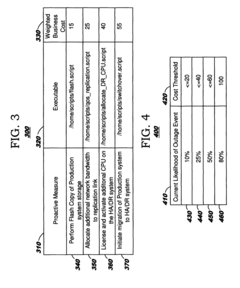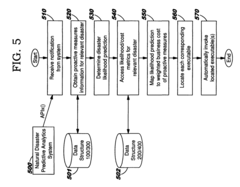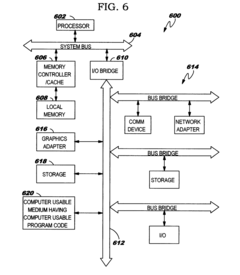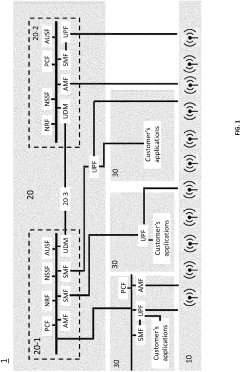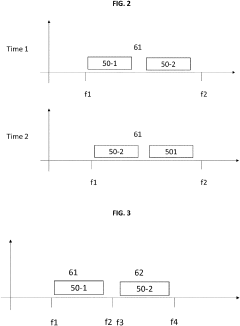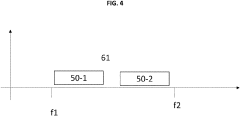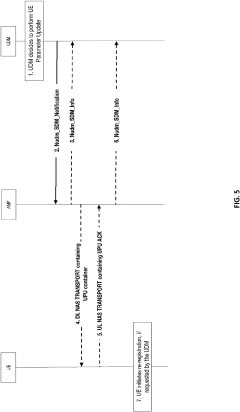What are the Benefits of 5G UC for Improved Disaster Prediction Models?
JUL 18, 20259 MIN READ
Generate Your Research Report Instantly with AI Agent
Patsnap Eureka helps you evaluate technical feasibility & market potential.
5G UC and Disaster Prediction: Background and Objectives
The convergence of 5G Ultra-Capacity (UC) technology and disaster prediction models represents a significant leap forward in our ability to anticipate and mitigate natural disasters. This technological synergy has emerged as a critical area of research and development, driven by the increasing frequency and severity of climate-related catastrophes worldwide.
5G UC, the latest iteration of cellular network technology, offers unprecedented capabilities in terms of data transmission speed, low latency, and massive device connectivity. These features are particularly relevant to disaster prediction models, which rely heavily on real-time data collection, processing, and analysis from a vast array of sensors and devices deployed across diverse geographical locations.
The evolution of disaster prediction models has been marked by a continuous quest for more accurate, timely, and actionable forecasts. Traditional methods, often limited by computational power and data availability, have struggled to keep pace with the complexity and dynamism of natural phenomena. The integration of 5G UC technology into these models promises to address many of these limitations, potentially revolutionizing our approach to disaster preparedness and response.
One of the primary objectives of this technological integration is to enhance the spatial and temporal resolution of prediction models. By leveraging the high-bandwidth and low-latency characteristics of 5G UC, researchers aim to incorporate more granular data from a wider range of sources, including IoT devices, satellite imagery, and social media feeds. This wealth of information, when processed in near real-time, can significantly improve the accuracy and reliability of disaster forecasts.
Another key goal is to reduce the time gap between data collection and actionable insights. The ultra-low latency of 5G UC networks enables near-instantaneous transmission of critical data, allowing prediction models to update and refine their forecasts continuously. This real-time capability is crucial in scenarios where every minute counts, such as in the case of rapidly developing severe weather events or seismic activities.
Furthermore, the integration of 5G UC with disaster prediction models aims to democratize access to early warning systems. By enabling more efficient data distribution and processing at the edge, this technology combination could make sophisticated prediction capabilities available to a broader range of communities, including those in remote or underserved areas.
As we delve deeper into this technological frontier, it becomes clear that the potential benefits of 5G UC for improved disaster prediction models are vast and multifaceted. The subsequent sections of this report will explore these advantages in detail, examining the current state of the technology, its challenges, and the promising avenues for future development.
5G UC, the latest iteration of cellular network technology, offers unprecedented capabilities in terms of data transmission speed, low latency, and massive device connectivity. These features are particularly relevant to disaster prediction models, which rely heavily on real-time data collection, processing, and analysis from a vast array of sensors and devices deployed across diverse geographical locations.
The evolution of disaster prediction models has been marked by a continuous quest for more accurate, timely, and actionable forecasts. Traditional methods, often limited by computational power and data availability, have struggled to keep pace with the complexity and dynamism of natural phenomena. The integration of 5G UC technology into these models promises to address many of these limitations, potentially revolutionizing our approach to disaster preparedness and response.
One of the primary objectives of this technological integration is to enhance the spatial and temporal resolution of prediction models. By leveraging the high-bandwidth and low-latency characteristics of 5G UC, researchers aim to incorporate more granular data from a wider range of sources, including IoT devices, satellite imagery, and social media feeds. This wealth of information, when processed in near real-time, can significantly improve the accuracy and reliability of disaster forecasts.
Another key goal is to reduce the time gap between data collection and actionable insights. The ultra-low latency of 5G UC networks enables near-instantaneous transmission of critical data, allowing prediction models to update and refine their forecasts continuously. This real-time capability is crucial in scenarios where every minute counts, such as in the case of rapidly developing severe weather events or seismic activities.
Furthermore, the integration of 5G UC with disaster prediction models aims to democratize access to early warning systems. By enabling more efficient data distribution and processing at the edge, this technology combination could make sophisticated prediction capabilities available to a broader range of communities, including those in remote or underserved areas.
As we delve deeper into this technological frontier, it becomes clear that the potential benefits of 5G UC for improved disaster prediction models are vast and multifaceted. The subsequent sections of this report will explore these advantages in detail, examining the current state of the technology, its challenges, and the promising avenues for future development.
Market Demand for Advanced Disaster Prediction Systems
The market demand for advanced disaster prediction systems has been steadily increasing in recent years, driven by the growing frequency and severity of natural disasters worldwide. Climate change has exacerbated the occurrence of extreme weather events, leading to significant economic losses and human casualties. This has created a pressing need for more accurate and timely disaster prediction models.
Governments, emergency response organizations, and private sector entities are actively seeking innovative solutions to enhance their disaster preparedness and mitigation strategies. The integration of 5G UC (Ultra-Capacity) technology into disaster prediction models offers a promising avenue to address these challenges, sparking considerable interest across various sectors.
The insurance industry, in particular, has shown a keen interest in advanced disaster prediction systems. Improved forecasting capabilities can help insurers better assess risks, optimize pricing models, and reduce potential losses. This has led to increased investment in research and development of sophisticated prediction tools that leverage 5G UC capabilities.
Urban planners and city administrators are another key market segment driving demand for these systems. As urbanization continues to accelerate globally, the need for real-time, high-resolution data to inform disaster response and infrastructure planning has become critical. 5G UC-enabled prediction models can provide the granular insights necessary for effective urban resilience strategies.
The agriculture sector represents a significant market for advanced disaster prediction systems. Farmers and agribusinesses are increasingly reliant on accurate weather forecasts and early warning systems to protect crops and livestock from extreme weather events. The enhanced data transmission and processing capabilities offered by 5G UC can greatly improve the precision and timeliness of these predictions.
Telecommunications companies are also recognizing the potential of 5G UC in disaster prediction as a value-added service for their networks. By offering advanced prediction capabilities to their customers, telcos can differentiate their services and create new revenue streams in an increasingly competitive market.
The global market for disaster management solutions, including prediction systems, is projected to grow substantially in the coming years. This growth is fueled by increasing government investments in disaster preparedness, rising awareness of climate change impacts, and technological advancements in data analytics and artificial intelligence.
As the benefits of 5G UC for improved disaster prediction models become more apparent, the market demand is expected to expand further. Organizations across various sectors are recognizing the potential of these advanced systems to save lives, protect assets, and enhance overall resilience in the face of increasing natural disasters.
Governments, emergency response organizations, and private sector entities are actively seeking innovative solutions to enhance their disaster preparedness and mitigation strategies. The integration of 5G UC (Ultra-Capacity) technology into disaster prediction models offers a promising avenue to address these challenges, sparking considerable interest across various sectors.
The insurance industry, in particular, has shown a keen interest in advanced disaster prediction systems. Improved forecasting capabilities can help insurers better assess risks, optimize pricing models, and reduce potential losses. This has led to increased investment in research and development of sophisticated prediction tools that leverage 5G UC capabilities.
Urban planners and city administrators are another key market segment driving demand for these systems. As urbanization continues to accelerate globally, the need for real-time, high-resolution data to inform disaster response and infrastructure planning has become critical. 5G UC-enabled prediction models can provide the granular insights necessary for effective urban resilience strategies.
The agriculture sector represents a significant market for advanced disaster prediction systems. Farmers and agribusinesses are increasingly reliant on accurate weather forecasts and early warning systems to protect crops and livestock from extreme weather events. The enhanced data transmission and processing capabilities offered by 5G UC can greatly improve the precision and timeliness of these predictions.
Telecommunications companies are also recognizing the potential of 5G UC in disaster prediction as a value-added service for their networks. By offering advanced prediction capabilities to their customers, telcos can differentiate their services and create new revenue streams in an increasingly competitive market.
The global market for disaster management solutions, including prediction systems, is projected to grow substantially in the coming years. This growth is fueled by increasing government investments in disaster preparedness, rising awareness of climate change impacts, and technological advancements in data analytics and artificial intelligence.
As the benefits of 5G UC for improved disaster prediction models become more apparent, the market demand is expected to expand further. Organizations across various sectors are recognizing the potential of these advanced systems to save lives, protect assets, and enhance overall resilience in the face of increasing natural disasters.
Current State and Challenges in 5G UC for Disaster Prediction
The integration of 5G Ultra-Capacity (UC) technology into disaster prediction models represents a significant advancement in the field of emergency management and risk mitigation. Currently, 5G UC is being deployed in various regions, offering enhanced connectivity and data transmission capabilities. This technology provides faster speeds, lower latency, and increased network capacity compared to previous generations of cellular networks.
In the context of disaster prediction, 5G UC enables the rapid collection and processing of vast amounts of data from diverse sources, including environmental sensors, satellite imagery, and social media feeds. This real-time data aggregation allows for more accurate and timely predictions of natural disasters such as hurricanes, earthquakes, and floods. The high-bandwidth capabilities of 5G UC support the transmission of high-resolution imagery and video, crucial for detailed analysis of potential disaster areas.
However, the implementation of 5G UC for disaster prediction faces several challenges. One significant hurdle is the uneven distribution of 5G infrastructure, particularly in rural or remote areas that are often most vulnerable to natural disasters. This disparity in coverage can lead to inconsistencies in data collection and prediction accuracy across different regions.
Another challenge lies in the integration of 5G UC with existing disaster prediction systems and models. Many current systems are not designed to handle the volume and velocity of data that 5G networks can provide, necessitating significant upgrades to data processing and analysis capabilities. This integration process requires substantial investment in both hardware and software infrastructure.
Data security and privacy concerns also present challenges in the widespread adoption of 5G UC for disaster prediction. The increased connectivity and data flow raise questions about the protection of sensitive information and the potential for unauthorized access to critical systems.
Furthermore, the reliability of 5G networks during extreme weather conditions or in the aftermath of a disaster remains a concern. While 5G technology offers improved resilience compared to previous generations, ensuring continuous operation in severe conditions is crucial for effective disaster response and recovery efforts.
Despite these challenges, the potential benefits of 5G UC for disaster prediction are substantial. The technology promises to enhance the accuracy and timeliness of predictions, potentially saving lives and reducing economic losses. As the deployment of 5G UC continues to expand and these challenges are addressed, its role in disaster prediction and management is expected to grow significantly, marking a new era in proactive disaster mitigation strategies.
In the context of disaster prediction, 5G UC enables the rapid collection and processing of vast amounts of data from diverse sources, including environmental sensors, satellite imagery, and social media feeds. This real-time data aggregation allows for more accurate and timely predictions of natural disasters such as hurricanes, earthquakes, and floods. The high-bandwidth capabilities of 5G UC support the transmission of high-resolution imagery and video, crucial for detailed analysis of potential disaster areas.
However, the implementation of 5G UC for disaster prediction faces several challenges. One significant hurdle is the uneven distribution of 5G infrastructure, particularly in rural or remote areas that are often most vulnerable to natural disasters. This disparity in coverage can lead to inconsistencies in data collection and prediction accuracy across different regions.
Another challenge lies in the integration of 5G UC with existing disaster prediction systems and models. Many current systems are not designed to handle the volume and velocity of data that 5G networks can provide, necessitating significant upgrades to data processing and analysis capabilities. This integration process requires substantial investment in both hardware and software infrastructure.
Data security and privacy concerns also present challenges in the widespread adoption of 5G UC for disaster prediction. The increased connectivity and data flow raise questions about the protection of sensitive information and the potential for unauthorized access to critical systems.
Furthermore, the reliability of 5G networks during extreme weather conditions or in the aftermath of a disaster remains a concern. While 5G technology offers improved resilience compared to previous generations, ensuring continuous operation in severe conditions is crucial for effective disaster response and recovery efforts.
Despite these challenges, the potential benefits of 5G UC for disaster prediction are substantial. The technology promises to enhance the accuracy and timeliness of predictions, potentially saving lives and reducing economic losses. As the deployment of 5G UC continues to expand and these challenges are addressed, its role in disaster prediction and management is expected to grow significantly, marking a new era in proactive disaster mitigation strategies.
Existing 5G UC Solutions for Disaster Prediction Models
01 5G UC network-based disaster prediction models
Utilizing 5G Ultra-Capacity networks to develop and implement advanced disaster prediction models. These models leverage the high-speed, low-latency capabilities of 5G UC to process vast amounts of real-time data from various sensors and sources, enabling more accurate and timely predictions of natural disasters and other emergencies.- 5G UC network-based disaster prediction models: Utilizing 5G Ultra-Capacity networks to develop and implement advanced disaster prediction models. These models leverage the high-speed, low-latency capabilities of 5G UC to process vast amounts of real-time data from various sensors and sources, enabling more accurate and timely predictions of natural disasters and other emergencies.
- AI-driven disaster prediction algorithms for 5G UC: Integration of artificial intelligence and machine learning algorithms specifically designed for 5G UC networks to enhance disaster prediction capabilities. These AI-driven models can analyze complex patterns in environmental data, historical disaster information, and real-time sensor inputs to provide more precise forecasts and risk assessments.
- Edge computing for localized disaster prediction in 5G UC: Implementing edge computing solutions within the 5G UC infrastructure to enable localized disaster prediction and early warning systems. This approach reduces latency and improves the speed of data processing, allowing for faster response times in critical situations and more efficient use of network resources.
- Multi-source data fusion for comprehensive disaster prediction: Developing methods to integrate and analyze data from multiple sources, including IoT devices, satellites, weather stations, and social media, using 5G UC networks. This comprehensive approach to data fusion enables more holistic and accurate disaster prediction models, covering a wide range of potential hazards and their interconnected effects.
- Real-time monitoring and adaptive prediction systems: Creating adaptive disaster prediction systems that continuously update and refine their models based on real-time data received through 5G UC networks. These systems can dynamically adjust their predictions and risk assessments as new information becomes available, improving the accuracy and reliability of disaster forecasts over time.
02 AI-driven disaster risk assessment in 5G environments
Integrating artificial intelligence and machine learning algorithms with 5G UC networks to enhance disaster risk assessment. These AI-driven systems analyze complex patterns in environmental data, social media feeds, and historical disaster information to provide more comprehensive and dynamic risk evaluations.Expand Specific Solutions03 Edge computing for localized disaster prediction
Implementing edge computing solutions within 5G UC networks to enable localized disaster prediction and early warning systems. This approach reduces latency and improves the speed of data processing, allowing for faster response times in critical situations.Expand Specific Solutions04 IoT sensor integration for comprehensive disaster monitoring
Leveraging the massive connectivity capabilities of 5G UC to integrate a wide array of IoT sensors for comprehensive disaster monitoring. This includes sensors for seismic activity, weather conditions, air quality, and water levels, providing a holistic view of potential disaster scenarios.Expand Specific Solutions05 Real-time data fusion and visualization for disaster management
Utilizing 5G UC networks to enable real-time data fusion from multiple sources and advanced visualization techniques for disaster management. This approach enhances situational awareness and decision-making capabilities for emergency responders and disaster management teams.Expand Specific Solutions
Key Players in 5G UC and Disaster Prediction Industry
The 5G UC technology for improved disaster prediction models is in an early development stage, with significant potential for growth. The market size is expanding as more telecommunications companies and research institutions invest in this area. While the technology is not yet fully mature, it shows promise in enhancing disaster prediction capabilities. Key players like Samsung Electronics, Nokia Technologies, and QUALCOMM are driving innovation in 5G UC applications for disaster management. IBM and Microsoft are also contributing to the development of advanced prediction models leveraging 5G technology. As the technology evolves, collaboration between telecom providers, tech giants, and research institutions will be crucial for realizing its full potential in disaster prediction and management.
Nokia Technologies Oy
Technical Solution: Nokia's 5G UC solution for disaster prediction focuses on creating a resilient and adaptive network infrastructure. Their approach utilizes Nokia's AirScale Radio Access technology, which supports both sub-6 GHz and mmWave frequencies for comprehensive coverage[7]. Nokia has developed specialized network slicing techniques that prioritize disaster-related data traffic, ensuring uninterrupted communication during critical events. Their solution incorporates AI-driven predictive maintenance to minimize network downtime, crucial for continuous monitoring of potential disasters[8]. Nokia's end-to-end 5G portfolio includes advanced analytics tools that process vast amounts of sensor data in real-time, enhancing the accuracy and timeliness of disaster predictions[9].
Strengths: Comprehensive end-to-end 5G solutions, strong presence in network infrastructure market. Weaknesses: Less experience in consumer-facing applications, potential challenges in integrating with legacy systems.
AT&T Intellectual Property I LP
Technical Solution: AT&T's 5G UC implementation for disaster prediction leverages their extensive network infrastructure and FirstNet public safety network. Their solution utilizes dynamic spectrum sharing to optimize bandwidth allocation for critical services[4]. AT&T has developed a cloud-native 5G core that supports network slicing, ensuring dedicated resources for disaster monitoring and prediction systems[5]. They've also implemented Multi-access Edge Computing (MEC) to process data closer to the source, reducing latency for time-sensitive predictions. AT&T's approach integrates AI and machine learning algorithms to analyze historical and real-time data, improving the accuracy of disaster forecasts[6].
Strengths: Extensive network coverage, experience with public safety communications. Weaknesses: Potential regulatory challenges, dependency on government contracts for large-scale implementation.
Core Innovations in 5G UC for Disaster Forecasting
Using predictive analytics of natural disaster to cost and proactively invoke high-availability preparedness functions in a computing environment
PatentActiveUS10169139B2
Innovation
- Implementing a predictive analytics system that uses data structures to assess the likelihood and cost of natural disasters, automatically invoking proactive measures such as workload shifting and unscheduled backups to maintain high availability, leveraging existing natural disaster prediction models for cost-benefit analysis.
Network slicing based campus networks
PatentActiveUS20230189133A1
Innovation
- A 5G network architecture with functionally separated 5GC instances, including a central cloud hosting both public and private networks as Network Slices, with Unified Data Management and Network Slice Selection Functionality, allowing for isolated and efficient operation by sharing components and tools while ensuring data sovereignty and security.
Regulatory Framework for 5G UC in Disaster Management
The regulatory framework for 5G UC in disaster management is a critical aspect of implementing this technology for improved disaster prediction models. As 5G UC technology continues to evolve and demonstrate its potential in enhancing disaster management capabilities, governments and regulatory bodies are working to establish comprehensive guidelines and policies to govern its use.
One of the primary focuses of the regulatory framework is ensuring the allocation of appropriate spectrum for 5G UC applications in disaster management. Regulatory bodies are tasked with identifying and reserving specific frequency bands that can be utilized for emergency communications and data transmission during disasters. This allocation must balance the needs of disaster management with other commercial and public uses of the spectrum.
Data privacy and security regulations play a crucial role in the framework, as 5G UC enables the collection and transmission of vast amounts of sensitive information during disaster situations. Regulatory bodies are implementing strict guidelines for data protection, encryption standards, and access controls to safeguard personal and critical infrastructure data while allowing for efficient information sharing among authorized entities.
Interoperability standards are another key component of the regulatory framework. As 5G UC systems for disaster management may need to integrate with existing emergency response networks and communication systems, regulators are establishing protocols to ensure seamless interaction between different technologies and platforms. This includes defining common data formats, communication protocols, and interface standards.
The framework also addresses the deployment and maintenance of 5G UC infrastructure for disaster management. Regulations are being put in place to ensure the resilience and reliability of these systems, including requirements for backup power, redundancy, and physical security measures. Additionally, guidelines for rapid deployment of temporary 5G UC networks in disaster-affected areas are being developed to enable quick response and recovery efforts.
Liability and accountability considerations are incorporated into the regulatory framework, defining the responsibilities of various stakeholders involved in 5G UC-based disaster management systems. This includes telecommunications providers, equipment manufacturers, software developers, and government agencies. Clear guidelines are being established to determine liability in cases of system failures or data breaches during critical disaster response operations.
International cooperation and harmonization of regulations are essential aspects of the framework, given the cross-border nature of many disasters. Regulatory bodies are working towards establishing international agreements and standards for 5G UC in disaster management, facilitating seamless coordination and information sharing across national boundaries during large-scale emergencies.
One of the primary focuses of the regulatory framework is ensuring the allocation of appropriate spectrum for 5G UC applications in disaster management. Regulatory bodies are tasked with identifying and reserving specific frequency bands that can be utilized for emergency communications and data transmission during disasters. This allocation must balance the needs of disaster management with other commercial and public uses of the spectrum.
Data privacy and security regulations play a crucial role in the framework, as 5G UC enables the collection and transmission of vast amounts of sensitive information during disaster situations. Regulatory bodies are implementing strict guidelines for data protection, encryption standards, and access controls to safeguard personal and critical infrastructure data while allowing for efficient information sharing among authorized entities.
Interoperability standards are another key component of the regulatory framework. As 5G UC systems for disaster management may need to integrate with existing emergency response networks and communication systems, regulators are establishing protocols to ensure seamless interaction between different technologies and platforms. This includes defining common data formats, communication protocols, and interface standards.
The framework also addresses the deployment and maintenance of 5G UC infrastructure for disaster management. Regulations are being put in place to ensure the resilience and reliability of these systems, including requirements for backup power, redundancy, and physical security measures. Additionally, guidelines for rapid deployment of temporary 5G UC networks in disaster-affected areas are being developed to enable quick response and recovery efforts.
Liability and accountability considerations are incorporated into the regulatory framework, defining the responsibilities of various stakeholders involved in 5G UC-based disaster management systems. This includes telecommunications providers, equipment manufacturers, software developers, and government agencies. Clear guidelines are being established to determine liability in cases of system failures or data breaches during critical disaster response operations.
International cooperation and harmonization of regulations are essential aspects of the framework, given the cross-border nature of many disasters. Regulatory bodies are working towards establishing international agreements and standards for 5G UC in disaster management, facilitating seamless coordination and information sharing across national boundaries during large-scale emergencies.
Environmental Impact of 5G UC Disaster Prediction Systems
The implementation of 5G UC (Ultra-Capacity) technology in disaster prediction models brings significant environmental benefits while also presenting some challenges. One of the primary advantages is the reduced energy consumption in data collection and transmission processes. The high-speed, low-latency nature of 5G UC allows for more efficient data transfer, reducing the overall power requirements of the prediction systems.
Furthermore, 5G UC enables the deployment of a greater number of IoT sensors and devices for environmental monitoring. This increased sensor density provides more accurate and comprehensive data for disaster prediction models, potentially leading to earlier and more precise warnings. As a result, communities can better prepare for and mitigate the impacts of natural disasters, reducing environmental damage and resource waste associated with recovery efforts.
The improved connectivity offered by 5G UC also facilitates the integration of diverse data sources, including satellite imagery, weather stations, and social media feeds. This holistic approach to data collection enhances the accuracy of prediction models, potentially reducing false alarms and unnecessary evacuations, which can have significant environmental impacts.
However, the widespread deployment of 5G UC infrastructure for disaster prediction systems may have some negative environmental consequences. The installation of new cell towers and small cells required for 5G UC coverage could lead to habitat disruption and increased energy consumption during the construction phase. Additionally, the production and disposal of 5G-enabled devices and sensors may contribute to electronic waste if not properly managed.
On the positive side, 5G UC can support more sophisticated edge computing capabilities, allowing for localized data processing and reducing the need for large, energy-intensive data centers. This decentralized approach not only improves the resilience of disaster prediction systems but also minimizes the carbon footprint associated with data transmission and processing.
The real-time capabilities of 5G UC enable more dynamic and adaptive disaster prediction models. These models can continuously update and refine their predictions based on incoming data, potentially leading to more targeted and efficient resource allocation during disaster response. This precision can help minimize unnecessary environmental disturbances and optimize the use of resources in disaster-prone areas.
In conclusion, while the environmental impact of 5G UC disaster prediction systems is not without challenges, the potential benefits in terms of improved disaster preparedness, reduced resource waste, and enhanced environmental monitoring capabilities outweigh the drawbacks. As the technology matures and becomes more widespread, it is crucial to focus on sustainable implementation practices to maximize its positive environmental impact.
Furthermore, 5G UC enables the deployment of a greater number of IoT sensors and devices for environmental monitoring. This increased sensor density provides more accurate and comprehensive data for disaster prediction models, potentially leading to earlier and more precise warnings. As a result, communities can better prepare for and mitigate the impacts of natural disasters, reducing environmental damage and resource waste associated with recovery efforts.
The improved connectivity offered by 5G UC also facilitates the integration of diverse data sources, including satellite imagery, weather stations, and social media feeds. This holistic approach to data collection enhances the accuracy of prediction models, potentially reducing false alarms and unnecessary evacuations, which can have significant environmental impacts.
However, the widespread deployment of 5G UC infrastructure for disaster prediction systems may have some negative environmental consequences. The installation of new cell towers and small cells required for 5G UC coverage could lead to habitat disruption and increased energy consumption during the construction phase. Additionally, the production and disposal of 5G-enabled devices and sensors may contribute to electronic waste if not properly managed.
On the positive side, 5G UC can support more sophisticated edge computing capabilities, allowing for localized data processing and reducing the need for large, energy-intensive data centers. This decentralized approach not only improves the resilience of disaster prediction systems but also minimizes the carbon footprint associated with data transmission and processing.
The real-time capabilities of 5G UC enable more dynamic and adaptive disaster prediction models. These models can continuously update and refine their predictions based on incoming data, potentially leading to more targeted and efficient resource allocation during disaster response. This precision can help minimize unnecessary environmental disturbances and optimize the use of resources in disaster-prone areas.
In conclusion, while the environmental impact of 5G UC disaster prediction systems is not without challenges, the potential benefits in terms of improved disaster preparedness, reduced resource waste, and enhanced environmental monitoring capabilities outweigh the drawbacks. As the technology matures and becomes more widespread, it is crucial to focus on sustainable implementation practices to maximize its positive environmental impact.
Unlock deeper insights with Patsnap Eureka Quick Research — get a full tech report to explore trends and direct your research. Try now!
Generate Your Research Report Instantly with AI Agent
Supercharge your innovation with Patsnap Eureka AI Agent Platform!
